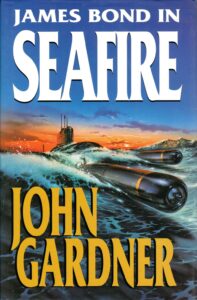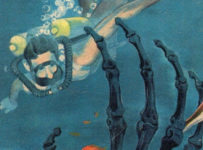Bond. James Bond. In the 007 Case Files, join me as I read all of the James Bond books, encompassing Ian Fleming and beyond. For Your Eyes Only: there’s spoilers ahead.
“The Cold War was over,” writes John Gardner near the start of his 1994 novel. “Now they were engaged in what might be called a Tepid War: one in which even their allies were suspect, and their former enemies required watching like viruses under a microscope.”
You can almost hear the lamenting sigh behind this one line. Gardner’s Bond had witnessed the height of the tensions between the USSR and the US, the fall of the Berlin Wall and the rise of a different kind of terrorism and espionage. Nevertheless, the villain and the plotting of SEAFIRE is very old school, drawing on a kind of megalomania that harks back to the earliest days of 007. At the same time, the rise of right wing groups and the unmitigated influence of a billionaire feels decidedly contemporary by 2022 standards.
When we first encounter our friend James in this book, he is enjoying a cruise with former Swiss Intelligence agent Flicka von Grüsse, who you might remember from Never Send Flowers (1993). Their relationship has grown stronger, but they continue to keep it a secret for fear that their employers will stop allowing them to work together. Following an attack on the ship, Bond and Flicka are hot on the trail of billionaire Sir Maxwell Tarn, who believes himself to be the next Hitler — but for the ‘90s.
Bond having a serious girlfriend isn’t the only change in his life. The Double-O section has been reorganised to bear little resemblance to its predecessor. Bond now commands the colloquially named Two Zeros, now answerable to a Watch Committee dubbed MicroGlobe One. The accountability of the public service is just another sign of the times that Gardner just loves peppering through his up-to-the-minute narratives.
Thanks to all those other traditional elements, Gardner keeps a taut pace throughout. When Bond isn’t making love to Flicka, which he does with regularity in the first half of the book, he’s dodging a gender-swapping bodyguard duo, and getting involved in chase scenes. There’s a few moments where Gardner does a pretty decent impersonation of a horror novel as well, such as the discovery of a beaten body swinging from a crossbeam, left on display for the spies in a darkened room. Bond is a fully-fledged, genre-spanning hero: all while driving a cream-coloured VW Corrado.

To contrast the super spy is the unambiguous villainy of Max Tarn, who is allowed to rise in the wake of right wing revivalists. Early on, Bond says he looks “like the Prince of Darkness.” Gardner describes Tarn as the kind of man who could bring down countries while charming your pants off. “Max Tarn is not just another fascist,” explains one character. “Max Tarn thinks of himself as the Nazi Messiah. He’s the reincarnation of Hitler, Himmler, Goebbels – you name them, he is it.” We’re told he “owns…an African-American girl who happens to be a junkie” and that he’s “politically slightly to the right of Adolph Hitler and Genghis Khan.” Gardner leaves us in no doubt that Tarn is a bad apple, and perhaps takes some delight in finishing him off by pummeling with him no less than two flares, setting him alight, taking his head clean off with an SAS shotgun blast, and then sending him tumbling off the edge of some battlements. Nazis: we hate those guys!
The most delightful element of the book remains Flicka, just as was the case in Never Send Flowers. Depicted as Bond’s equal, it’s actually a great character progression to see him remain with a single girlfriend across multiple books. When the decide they want to get married, you can almost feel the tension mounting in the book. After all, Bond’s last two great loves, Vesper Lynd and “Tracy” di Vicenzo, did not have happy endings.
Gardner doesn’t completely escape the trope of ‘fridging’ a female lead for the motivation of the male hero. Despite a rather brutal treatment at the hands of Tarn, she survives the book, albeit with some life-threatening injuries. In this rather dour ending, one can’t help but think of On Her Majesty’s Secret Service. Gardner leaves us with Bond weeping over Flicka’s broken body, continuing to follow Fleming’s line of Bond being drawn to women with physical disfigurements. Speaking of Fleming, this is a redemption of sorts and full circle from Vesper and Tracy, allowing Bond to love completely and also let the woman actually live. Of course, Gardner would change that later.
In many ways, SEAFIRE feels like Gardner bidding farewell to a character he’d been writing for at least 13 years at this point. For this reason, he allows himself some meta indulgences, such as the sort-of eponymously named Rendrag Associates, and a cheeky reference to Drinkmanship turning up their noses at Bond’s favourite martini recipe. Yet Gardner still had two books left in his tenure, one of which was the novelisation of GoldenEye, a film that marked the cinematic return of Bond after a six year absence. This may not be the height of Bond’s career, and the ending is often a convoluted mess, but it’s unabashedly fun.
James Bond will return…in GoldenEye.





